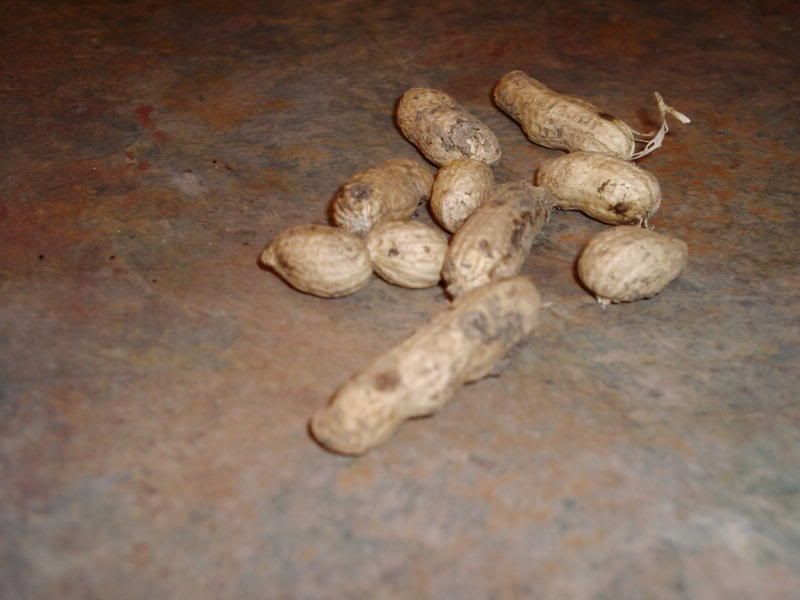The news this morning is full of features and editorials seeking to explain the shit storm of Salmonella produced by Peanut Corporation of America.
Chapman and I tried to take it a step further and focus on effective, long-term steps to reduce the incidence of foodborne illness from farm-to-fork. At this point in time, promoting food safety culture coupled with marketing and a series of carrots and sticks is the best we can come up with.
(1).jpg) In 1204 in Montpellier, France, a butcher selling a substitute meat in place of the advertized beast was required by statute to reimburse the customer twice the amount paid. In Narbonne, regulations dictated a whipping “with sheep tripe” in front of the food stall for unscrupulous sellers. China routinely executes its biggest food frauds.
In 1204 in Montpellier, France, a butcher selling a substitute meat in place of the advertized beast was required by statute to reimburse the customer twice the amount paid. In Narbonne, regulations dictated a whipping “with sheep tripe” in front of the food stall for unscrupulous sellers. China routinely executes its biggest food frauds.
During a hearing before the U.S. Senate Agriculture Committee looking into a salmonella outbreak linked to a Georgia peanut processing plant, Sen. Patrick Leahy of Vermont said Thursday that food producers responsible for widespread, deadly outbreaks of disease should face jail time, not just fines, to get food makers to take food safety seriously.
Sixteen years after E. coli O157:H7 killed four and sickened hundreds who ate hamburgers at the Jack-in-the-Box chain, the challenge remains: how to get people to take food safety seriously?
Lots of companies do take food safety seriously and the bulk of American meals are microbiologically safe. But recent food safety failures have been so extravagant, so insidious and so continual that consumers must feel betrayed.
The politicos in Washington are focused on legislative fixes, maybe creating a single-food inspection agency, maybe increasing inspections, insisting microbiological test results be submitted to government, maybe mandating jail time for the most audacious executives. Such moves may send a signal of hope and change, but will do little to reduce the carnage contaminated food and water wreak on the American public each year – 76 million illnesses and 5,000 deaths.
Industry – the folks that process peanuts and all those companies that make some of the 1,550 different peanut butter crackers, ice cream, energy bars and dog treats that have been recalled – is equally void of ideas. The system to ensure safe food relies largely on so-called third-party audits of suppliers, a system that glowingly approved Peanut Corporation of America and its leaky roof, filthy floors and rat-infested storage areas.
Other peanut butter manufacturers like Unilever and ConAgra Foods say they have “stringent food safety and quality control standards.” But neither will say what it is they do better than PCA; neither will say how often the plants test their finished product for foodborne illnesses or other contamination. Maple Leaf Foods in Canada, whose deli meats killed at least 20 Canadians last fall, says it has done 42,000 tests for listeria across 24 packaged meat plants in the past three months, but will not make the results publicly available for scrutiny.
.jpg) Even Whole Foods, where consumers pay a hefty premium for basic foodstuffs, said the company carefully checks the paperwork for all the products it sells, but can do no better than the minimal standard of government. “For the thousands of products we sell, that’s the extent we can go to. The rest of it is up to the F.D.A. and to the manufacturer.”
Even Whole Foods, where consumers pay a hefty premium for basic foodstuffs, said the company carefully checks the paperwork for all the products it sells, but can do no better than the minimal standard of government. “For the thousands of products we sell, that’s the extent we can go to. The rest of it is up to the F.D.A. and to the manufacturer.”
Like a fiscal house of cards, the Ponzi scheme of inspection and verification for food safety is collapsing with merely the mention of consumer scrutiny. Sort of like an eighth grade party with chaperones — just pop and chips. But when the inspector or auditors leaves, the party turns exciting (read all about it on Facebook).
A cultural shift is required for everyone, from the farm through to the fork, to take food safety seriously. Frank Yiannas, the vice-president of food safety at Wal-Mart has taken an initial stab in his new book, Food Safety Culture: Creating a Behavior-based Food Safety Management System.
Yiannas says that an organization’s food safety systems need to be an integral part of its culture. At Peanut Corporation of America, former employees are now coming forward to tell of filthy conditions in the Blakely, Georgia, processing plant. A company with a strong food safety culture would have encouraged those employees to speak up while they were employed, not because the manager or auditor or inspector was watching, but because it was the right thing to do.
The best food producers, processors, retailers and restaurants should go above and beyond minimal government and auditor standards and sell food safety solutions directly to the public. The best organizations will use their own people to demand ingredients from the best suppliers; use a mixture of encouragement and enforcement to foster a food safety culture; and use technology to be transparent — whether it’s live webcams in the facility or real-time test results on the website — to help restore the shattered trust with the buying public.
Here’s what consumers can do: at the local market, the stop-n-shop or the supermarket, ask someone, how do I know this food won’t make me barf? While such talk may be socially frowned upon, it’s time to put aside the niceties and bureau-speak and talk directly about safe food.
The more customers ask, the more food providers will be encouraged to market their food safety efforts.
Just like in 13th century France.
Doug Powell is an associate professor of food safety at Kansas State University and the publisher of barfblog.com. Ben Chapman is a food safety extension specialist at North Carolina State University.
 Do you remember how you first heard about the latest round of Salmonella in the peanut butter? Was it on the evening news, in the paper, or did you hear about it through Facebook or Twitter? If you’re in the under 30 crowd you might fit into the latter category. Social networking sites, like Facebook, Twitter and MySpace are increasingly being utilized for up-to-the-minute recall information.
Do you remember how you first heard about the latest round of Salmonella in the peanut butter? Was it on the evening news, in the paper, or did you hear about it through Facebook or Twitter? If you’re in the under 30 crowd you might fit into the latter category. Social networking sites, like Facebook, Twitter and MySpace are increasingly being utilized for up-to-the-minute recall information.

 In a
In a 
.jpg) “While most successful food producers are far more diligent — big name-brand peanut butter is considered safe, for example — American consumers have faced far too many food-supply emergencies in the last few years.”
“While most successful food producers are far more diligent — big name-brand peanut butter is considered safe, for example — American consumers have faced far too many food-supply emergencies in the last few years.”(1)(1).jpg) “President Obama promised during the campaign to create a government that does a better job of protecting the American consumer. The nation’s vulnerable food supply is a healthy place to start.”
“President Obama promised during the campaign to create a government that does a better job of protecting the American consumer. The nation’s vulnerable food supply is a healthy place to start.”
 1. To begin with, there is no such thing as a “free” market for food…
1. To begin with, there is no such thing as a “free” market for food… If it is not likely that an incident/outbreak will be traced back to the producer responsible, the possibility of making a profit from a contaminated food may be greater than the chance they’ll get caught.
If it is not likely that an incident/outbreak will be traced back to the producer responsible, the possibility of making a profit from a contaminated food may be greater than the chance they’ll get caught. Parnell sat stiffly, his hands folded in his lap at the witness table, as Rep. Greg Walden, R-Ore., held up a clear jar of his company’s products wrapped in crime scene tape and asked him if he would be willing to eat the food.
Parnell sat stiffly, his hands folded in his lap at the witness table, as Rep. Greg Walden, R-Ore., held up a clear jar of his company’s products wrapped in crime scene tape and asked him if he would be willing to eat the food. Henry Waxman, chairman of the House Committee on Energy and Commerce, was quoted as saying, “This company cared more about its financial bottom line than it did about the safety of its customers.”
Henry Waxman, chairman of the House Committee on Energy and Commerce, was quoted as saying, “This company cared more about its financial bottom line than it did about the safety of its customers.”  Early reporting
Early reporting .jpg)
(1).jpg) In 1204 in Montpellier, France, a butcher selling a substitute meat in place of the advertized beast was required by statute to reimburse the customer twice the amount paid. In Narbonne, regulations dictated a whipping “with sheep tripe” in front of the food stall for unscrupulous sellers. China routinely executes its biggest food frauds.
In 1204 in Montpellier, France, a butcher selling a substitute meat in place of the advertized beast was required by statute to reimburse the customer twice the amount paid. In Narbonne, regulations dictated a whipping “with sheep tripe” in front of the food stall for unscrupulous sellers. China routinely executes its biggest food frauds..jpg) Even Whole Foods, where consumers pay a hefty premium for basic foodstuffs, said the company carefully checks the paperwork for all the products it sells, but can do no better than the minimal standard of government. “For the thousands of products we sell, that’s the extent we can go to. The rest of it is up to the F.D.A. and to the manufacturer.”
Even Whole Foods, where consumers pay a hefty premium for basic foodstuffs, said the company carefully checks the paperwork for all the products it sells, but can do no better than the minimal standard of government. “For the thousands of products we sell, that’s the extent we can go to. The rest of it is up to the F.D.A. and to the manufacturer.”